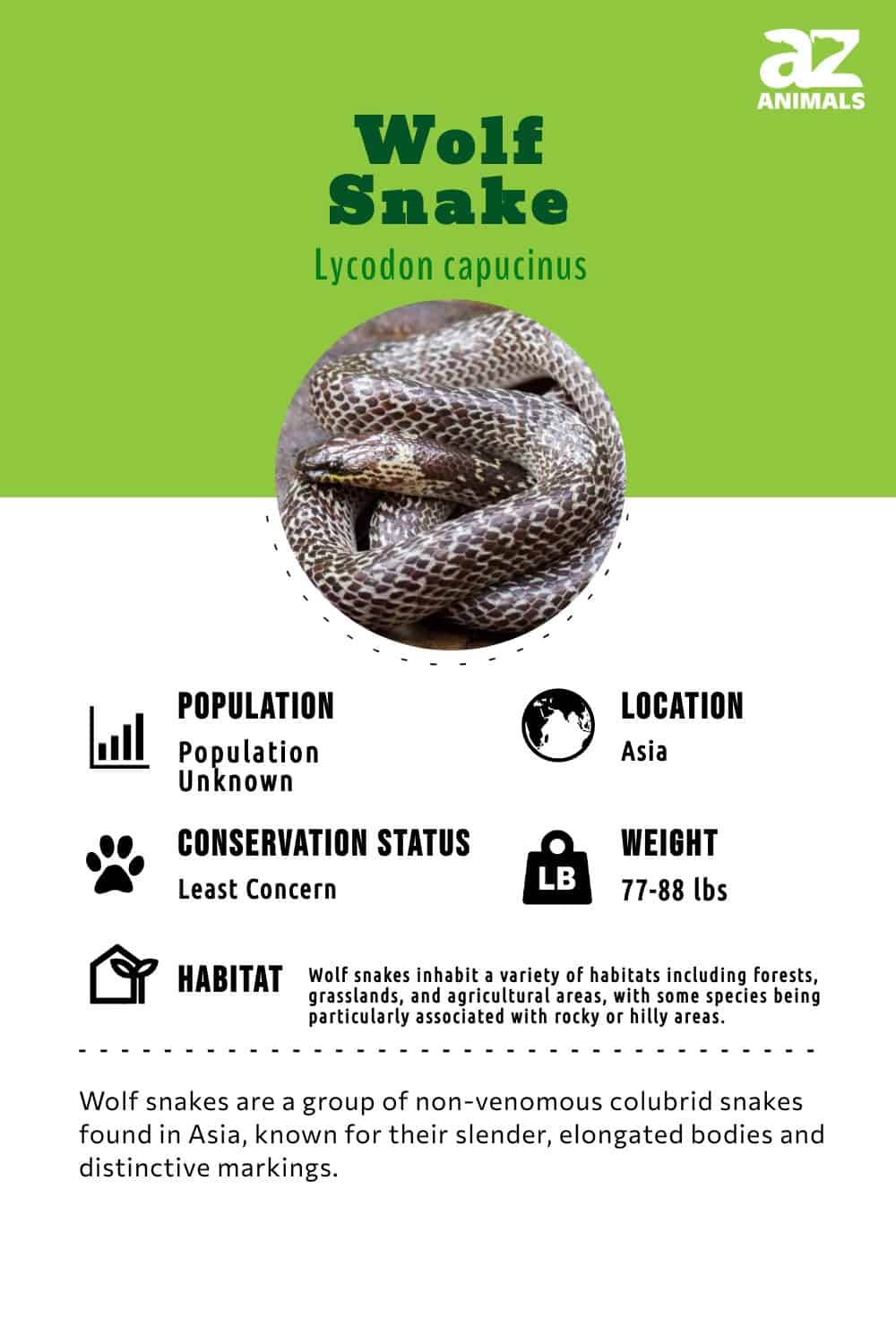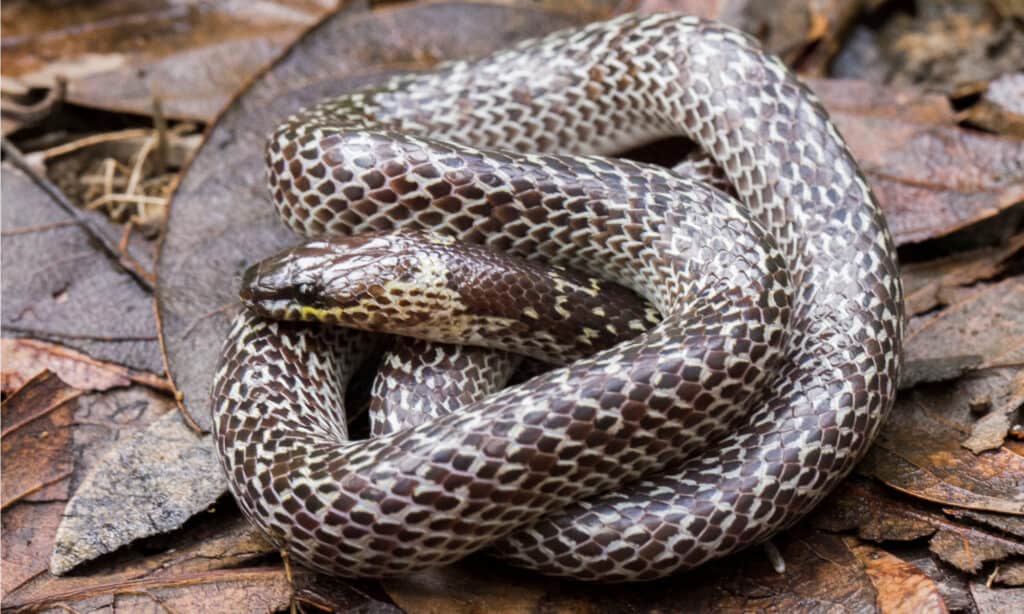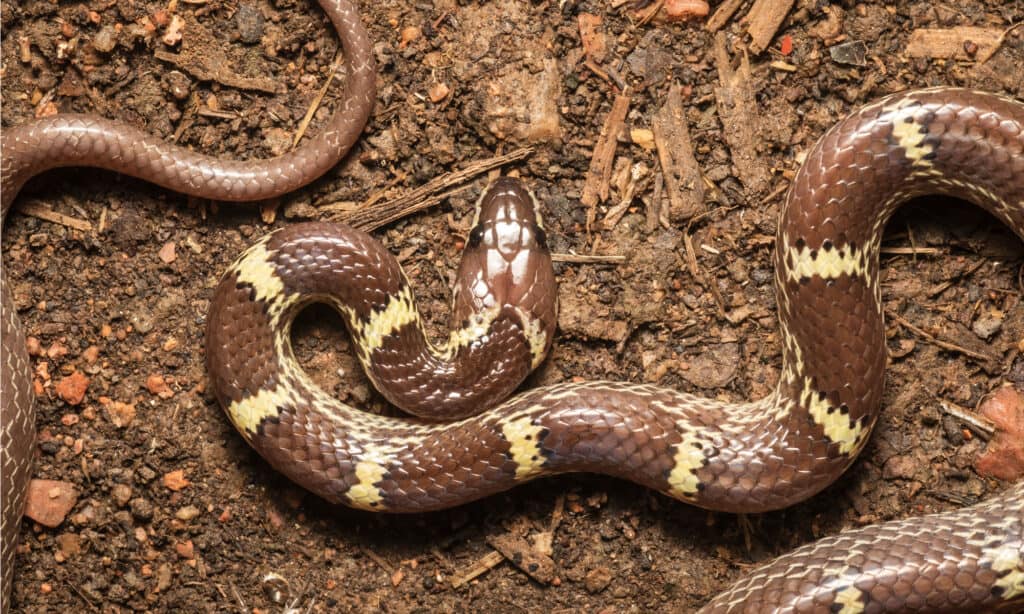Wolf Snake
Lycodon capucinus
Harmless, but with fangs like a wolf.
Advertisement
Wolf Snake Scientific Classification
- Kingdom
- Animalia
- Phylum
- Chordata
- Class
- Reptilia
- Order
- Squamata
- Family
- Colubridae
- Genus
- Lycodon
- Scientific Name
- Lycodon capucinus
Read our Complete Guide to Classification of Animals.
Wolf Snake Conservation Status
Wolf Snake Facts
Wolf Snake Physical Characteristics
- Color
- Grey
- Yellow
- Black
- White
- Lifespan
- About 10 years
- Length
- 20 inches
- Venomous
- Yes
- Aggression
- Medium
View all of the Wolf Snake images!

“Harmless, but with fangs like a wolf.”
Called the common wolf snake, the oriental wolf snake, the Indian wolf snake, the common wolf snake, or the house snake, Lycodon capucinus is found in much of southern Asia.
A reptile that’s small in size and slender, it is the bane of skinks and geckos, including those that like to live in people’s houses.
The pattern of scales on the snake’s back makes it distinctive from any other snake in its range.
Four Amazing Facts About Wolf Snakes

The wolf snake status of conservation is considered to be of “Least Concern” by the IUCN. Although being a common snake, it is rarely seen.
©dwi putra stock/Shutterstock.com
Here are four amazing facts about the wolf snake:
1. Their large front teeth give the snake its common name, but these teeth don’t inject venom. The venom-injecting fangs are at the back of the snake’s mouth.
2. Its snout is shaped like a duck’s bill and is used to burrow into the ground.
3. The common wolf snake is one of the fastest snakes on earth. It can gain speeds of up to 3.5 miles per hour.
4. Skinks are their preferred prey, and because skinks are often found near human habitation, so are wolf snakes.
Where To Find Wolf Snakes

Any of the non-venomous members of the Colubridae family that go by the term “wolf snake” have big fangs on both jaws.
©FunnyDive/Shutterstock.com
The wolf snake is found in many countries in southern Asia. These countries include Laos, Bangladesh, Indonesia, the Philippines, Thailand, and Cambodia. They’re also found in southeastern China and Hong Kong. It’s found in the lowland forests as well as places near and in human habitation where its favorite prey is found. It’s not unusual to find wolf snakes on roofs or climbing up straight walls.
Though they are most often found at sea level, some snakes have been found at elevations as high as 656 feet. The snake is elusive because it is active at night. Though it is common where it is found, and its conservation status is least concern the snake may be threatened by habitat destruction and indiscriminate killing.
Scientific Name

The Cape wolf snake (Lycophidion capense), which is widespread from South Africa to Egypt, is a small, dull species that preys primarily on lizards.
©sushil kumudini chikane/Shutterstock.com
The wolf snake’s scientific name is Lycodon capucinus. Lycodon comes from the Greek word for “wolf,” lycan, and the Greek word for “tooth,” which is odont. Capucinus is old French for “hood” or “cowl” and is derived from the Latin word for “hood” which is cappa. The genus name describes the snake’s wolf-like front teeth, and the epithet probably describes the white, hoodlike marking at the back of its head.
Evolution and Origins
The intriguing genus of snakes known as wolf snakes has evolved over millions of years to fit a variety of habitats throughout Asia. The earliest colubrid snakes appeared in the Late Cretaceous period, some 65 million years ago, and this is when wolf snakes first appeared.
Wolf snakes have evolved into numerous distinct species over time, each with a unique set of morphological and behavioral characteristics. Some species have evolved specific diets or distinctive reproductive methods, while others are terrestrial or arboreal.
To this day, wolf snakes continue to change and adapt to new settings despite the fact that they all have a common ancestor.
The Different Types of Wolf Snake
There seem to be only one species of wolf snake, but they have different colorations depending on where they are found. An Indian snake, for example, might have a different coloration than a Philippine snake even though they’re the same species. Albino wolf snakes are sometimes found in the wild, but the price of albinism is that the animal is easy to spot, and therefore easy pickings for predators.
Appearance and Description
The wolf snake has small size for a snake and rarely grows to 3 feet in length. Like many snake species, the female is often larger than the male. It is slender and whiplike, with a flat, wide head. Its coloration might be black, dark gray, or reddish-brown with a lighter, reticulated pattern.
Baby snakes are lighter than adults. Most of the snakes have a white collar or cowl-like marking around the back of the head or the neck. The belly is pale, and the large teeth in the snake’s upper jaw give it its generic name. These teeth don’t deliver venom but are used to grab and hold on to prey.
Population & Conservation Status
The IUCN Redlist of Threatened Species doesn’t display a population total connected to the wolf snake. However, the population of this snake is described as stable and even abundant with a status of Least Concern.
How Dangerous Are They?
Wolf snakes actually produce venom, but the venom is so weak that many herpetologists claim that they are basically nonvenomous. What there is of the snake’s venom is delivered via the fangs at the back of the mouth. This means that if the snake bites it will need to hold on and sort of chew to inject the venom. Still, the wolf snake has razor-sharp teeth, and its bite is painful. It can also excrete a bad-smelling musk.
Behavior and Humans
Wolf snakes are nocturnal and are often found hunting on open ground or through the shrubbery. The snake spends the day hidden away beneath rocks or tree stumps or in burrows dug into soft ground.
The snake is high-strung and is likely to bite if it’s molested, though some people still keep it as a pet. Its favorite prey is lizards, particularly skinks, and geckos but it will also take frogs, insects, and smaller mammals such as mice. Depending on where the snake is found, it will either quickly bite to defend itself or try to get away if someone tries to pick it up. If it’s near leaves, it might wriggle its tail to cause the leaves to rustle, thus mimicking the rattlesnake.
The snakes’ breeding period is before the monsoon. For the Indian snake, this means between December and January if they live in southern India and March to July if they live in northern India. The females lay from three to 11 eggs, and they hatch in the late summer and early fall. The hatchlings are independent at birth and are about 5.5 to 8 inches long. The wolf snake’s lifespan is about 10 years, which is fairly long for a small, wild snake.
Some people keep these graceful snakes as pets. The price for a healthy specimen can be about $140.00 plus shipping, and this doesn’t include the price of an artificial habitat or the price of food. Pet snakes can be fed small fish or pinkies made to smell like lizards.
View all 108 animals that start with WWolf Snake FAQs (Frequently Asked Questions)
Are wolf snakes venomous?
Wolf snakes are somewhat venomous. However, if you get bitten by one the bite will certainly hurt, and there may be some swelling, but the bite isn’t dangerous.
How do wolf snakes hunt?
Wolf snakes hunt by picking up scent molecules of their prey and following the scent. Once they find prey they grab it and hold it with their front fangs then swallow it whole.
Are wolf snakes aggressive?
Wolf snakes aren’t particularly aggressive towards humans, but they are said by some to be high-strung and quick to bite.
Where do wolf snakes live?
These snakes live in many places in south Asia. There are Philippine wolf snakes, Indian wolf snakes and wolf snakes from Myanmar, Bangladesh and Sulawesi.
What do wolf snakes eat?
These snakes mostly eat skinks and geckos, but can also eat small mammals, insects and frogs.
What is a wolf snake?
A wolf snake is a slender colubrid snake, small in size, that lives in the lowland forests of southern Asia. It gets its genus name because its front teeth resemble the fangs of a wolf.
Are wolf snakes poisonous?
Wolf snakes are not dangerously poisonous.
Is Philippine wolf snake venomous?
The snakes are venomous, but their venom is so mild that it is not dangerous to humans.
Why is it called a wolf snake?
It is called a wolf snake because its long front teeth call to mind the fangs of a wolf. Its head also has a canine look to some people.
How can you tell a wolf snake?
The patterns and coloration on the back of a wolf snake are different from any other snake in the places where it lives. It is also a rather small snake, rarely longer than 3 feet, with a snout shaped like a duck’s bill, a wide, flat head and a sort of white or yellow cowl or collar around its neck.
What are the differences between a stiletto snake and a wolf snake?
At first, it might be difficult to tell the difference because they are both slender, dark in color, and quick. But the most significant difference between them is the shape of their tails.
Thank you for reading! Have some feedback for us? Contact the AZ Animals editorial team.


















